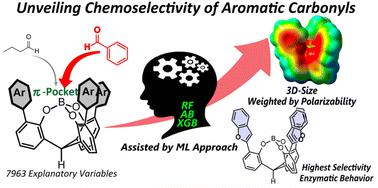当前位置:
X-MOL 学术
›
Org. Biomol. Chem.
›
论文详情
Our official English website, www.x-mol.net, welcomes your feedback! (Note: you will need to create a separate account there.)
Selective recognition between aromatics and aliphatics by cage-shaped borates supported by a machine learning approach
Organic & Biomolecular Chemistry ( IF 3.2 ) Pub Date : 2024-04-05 , DOI: 10.1039/d4ob00408f Yuya Tsutsui 1 , Issei Yanaka 2 , Kazuhiro Takeda 2 , Masaru Kondo 3 , Shinobu Takizawa 4 , Ryosuke Kojima 5 , Akihito Konishi 1, 6 , Makoto Yasuda 1, 6
Organic & Biomolecular Chemistry ( IF 3.2 ) Pub Date : 2024-04-05 , DOI: 10.1039/d4ob00408f Yuya Tsutsui 1 , Issei Yanaka 2 , Kazuhiro Takeda 2 , Masaru Kondo 3 , Shinobu Takizawa 4 , Ryosuke Kojima 5 , Akihito Konishi 1, 6 , Makoto Yasuda 1, 6
Affiliation

|
Selective recognition between hydrocarbon moieties is a longstanding issue. Although we developed a π-pocket Lewis acid catalyst with high selectivity for aromatic aldehydes over aliphatic ones, a general strategy for catalyst design remains elusive. As an approach that transfers the molecular recognition based on multiple cooperative non-covalent interactions within the π-pocket to a rational catalyst design, herein, we demonstrate Lewis acid catalysts showing improved selectivity through the support of an ensemble algorithm with random forest, Ada Boost, and XG Boost as a machine learning (ML) approach. Using 7963 explanatory variables extracted from model hetero-Diels–Alder reactions, the ensemble algorithm predicted the chemoselectivity of unlearned catalysts. Experiments confirmed the prediction. The proposed catalyst shows the highest selective recognition, reminiscing enzymatic catalytic activity. Additionally, a SHapley Additive exPlanations (SHAP) method suggested that the selectivity originates from the polarizability and three-dimensional size of the catalyst. This insight leads to rational design guidelines for Lewis acid catalysts with dispersion forces.
中文翻译:

机器学习方法支持的笼状硼酸盐选择性识别芳香族化合物和脂肪族化合物
烃部分之间的选择性识别是一个长期存在的问题。尽管我们开发了一种 π 袋路易斯酸催化剂,其对芳香醛的选择性高于脂肪醛,但催化剂设计的一般策略仍然难以捉摸。作为一种将基于 π 口袋内多种协作非共价相互作用的分子识别转移到合理催化剂设计的方法,本文中,我们证明路易斯酸催化剂通过随机森林 Ada Boost 集成算法的支持显示出更高的选择性,以及 XG Boost 作为一种机器学习 (ML) 方法。使用从异狄尔斯-阿尔德反应模型中提取的 7963 个解释变量,集成算法预测了未学习催化剂的化学选择性。实验证实了这一预测。所提出的催化剂显示出最高的选择性识别、回忆酶催化活性。此外,SHApley Additive exPlanations (SHAP) 方法表明选择性源于催化剂的极化率和三维尺寸。这一见解为具有分散力的路易斯酸催化剂提供了合理的设计指南。
更新日期:2024-04-05
中文翻译:

机器学习方法支持的笼状硼酸盐选择性识别芳香族化合物和脂肪族化合物
烃部分之间的选择性识别是一个长期存在的问题。尽管我们开发了一种 π 袋路易斯酸催化剂,其对芳香醛的选择性高于脂肪醛,但催化剂设计的一般策略仍然难以捉摸。作为一种将基于 π 口袋内多种协作非共价相互作用的分子识别转移到合理催化剂设计的方法,本文中,我们证明路易斯酸催化剂通过随机森林 Ada Boost 集成算法的支持显示出更高的选择性,以及 XG Boost 作为一种机器学习 (ML) 方法。使用从异狄尔斯-阿尔德反应模型中提取的 7963 个解释变量,集成算法预测了未学习催化剂的化学选择性。实验证实了这一预测。所提出的催化剂显示出最高的选择性识别、回忆酶催化活性。此外,SHApley Additive exPlanations (SHAP) 方法表明选择性源于催化剂的极化率和三维尺寸。这一见解为具有分散力的路易斯酸催化剂提供了合理的设计指南。



























 京公网安备 11010802027423号
京公网安备 11010802027423号